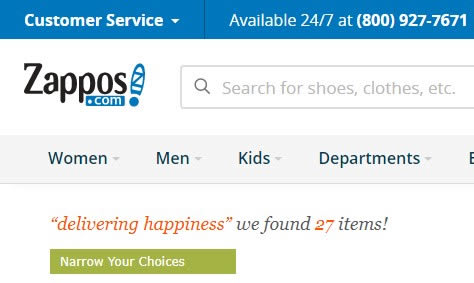In the age of digital price wars, me-too marketing, and copycat products comes the rise of customer experience as a competitive advantage.
While the former three can easily be duplicated by other companies, the way customers experience your company will forever be unique.
Unfortunately, given its importance as a brand differentiator, customer experience (CX) is also one of the most easily damaged.
And your digital promotions are most likely the saboteurs.
The Role of Digital Promotions in Customer Experience
In our online era, part of the customer experience stems from your digital promotions.
Thanks to outlets like social media, AdWords, email, and retargeting, companies have plenty of promotional opportunities to place their brand in front of their most likely customers.
In addition, consumers and businesses can easily discover new companies and stay connected with their favorite brands through digital advertising.
So how do you measure your digital campaign’s effectiveness?
Well, that depends on who you ask.
Talk to any marketer about how their last digital promotion performed, and they’re likely to tell you the new customers/sales/revenue the promotion brought in.
Which is great, especially if those numbers hit targets and made a profit. But what happens after the promotion ends?
Did you gain a customer for life, or just for the life of the promotion?
Did you deliver on a level of service that showed why you’re better than your competitors?
Did the customer’s experience align with your brand’s mission?
How does the customer view your company after the promotion compared to before?
These things aren’t as easily measured, yet they have everything to do with the true success of your digital campaign.
Typically, these answers come forth over time in the form of a growing or shrinking customer base and public opinion.
But it can be difficult to attribute these points to a particular campaign or promotion (or a series of them).
Nevertheless, the following three digital promotion blunders aren’t doing you any favors.
Recognize them, understand them, and avoid them before they deal heavy damage to your customer experience and, eventually, your entire brand value.
Step 1: Emphasizing Sales Over Value
Digital promotions can give your product a temporary sales bump, but that shouldn’t be your main focus.
Rather, your promotions should be an investment in your brand, not a race to the sales quota finish line.

Former JCPenney CEO Allen Questrom, who is credited with helping the department store turn around during the early 2000s, believes that promotions should contribute to sales, not pilot the entire selling strategy.
Often times companies will use discounts to fill in revenue gaps when business is slow, but these price drops fail to complete the customer experience with strong service, a solid product, and standout presentation.
Which means there’s nothing else to earn the future business of those who were only looking for a good deal.
Regular price promotions are the beginning of brand value erosion that becomes more noticeable over time.
But because of the sales spikes on certain items during those promotions, many companies don’t see the damage until they try to cut back on price drops.
At that point, it’s difficult to rebuild your brand’s worth, and often times nearly impossible to get along without offering the price breaks people have come to expect.
Case in point: another former JCPenney CEO, Ron Johnson, upended the company when he cut sales promotions in lieu of building everyday value.
This decision saw sales plummet $6 billion and over 40,000 workers were laid off.
Step 2: Focusing on Aspiration Over Inspiration
Questrom notes that Zara and Uniqlo, two retail clothing stores that aren’t dependent on sales to drive profits, recognize shoppers are looking for inspiration, not aspiration.
That is, consumers might not always know what they want, but will recognize something worthwhile when they see it.
From a seller’s perspective, aspiration in a digital campaign often takes the form of “If you’re looking for this, we’ve got it.”
But if you’re targeting only the ones who are specifically looking for what you offer, you’re ignoring the chance to inspire others with your product.
People are bound by their own creativity and don’t always realize a product’s potential.
That’s one reason why Pinterest soared in popularity. The bulletin board-esque social media website help people share ideas and gain inspiration that otherwise never would have been possible.
As a result, there are more than 50 billion Pins on the site, with 73% of Pinterest users indicating they purchased something they found on their Pinterest feed.

Coca Cola’s Share a Coke campaign represents one of the most memorable advertising campaigns that can only be described as inspirational.
It was a simple concept: print individual names on bottles of their drink and encourage consumers to “Share a Coke” with someone they know whose name matches the one on the drink.
The company not only saw a 7% boost in sales during its 2011 trial period, but also 18 million impressions on social media, an 870% rise in the company’s Facebook site, and a 39% bump in “Likes.”
Even consumers who don’t usually buy soft drinks might have felt the urge to share a Coke if they found a bottle with a loved one’s name.
Which shows that a little inspiration can go a long way.
Step 3: Failing to Involve Your Team
As much as your prospects need to know about your promotions, your team needs to know just as much. And it shouldn’t be insider knowledge reserved for your sales reps.
Every employee in your company, from customer service to tech support to sales and business analysts, is responsible for crafting your customer experience.
Their actions affect your company culture, which helps determine how customers interact with your brand.
And they need to be in the best position possible to ensure a seamless experience at every turn.

Zappos.com has been a leader in building a pervasive company culture.
Their “Powered By Service” motto isn’t just a tagline, but a daily philosophy that applies to every employee, regardless of job title.
Because of its prevalence within the company’s operations, the company continually receives fame regarding their culture.
Whether you’re running a single digital promotion to boost website traffic or running various promotions to highlight a new product, your team should know the what’s and why’s, as well as how these promotions may affect their job.
What You Can Do to Protect Your Customer Experience from Digital Campaign Failures
While digital promotions can help you earn viewership and market share, establishing long-term clientele can prove healthier for your P&L rather than the one-off sales from a coupon code.
Instead, every digital promotion should contribute to your brand’s value in a way that makes them want to do business with you, even when they have to pay full price. Here’s how:
Make your product stand out.
There’s an unwritten rule in business: If two companies are exactly the same, one isn’t necessary.
While you may offer the same or similar products as your competitors, your digital promotions should focus on what makes you different.
Your brand is unlike any other, which is why it should do all the talking when it comes to promoting your products.
Content Queen Ann Handley suggests creating campaign content based on what your customers want.
To find out what that is, exactly, you can monitor and manage your reputation through review sites like Yelp! or Google and see what customers are saying.
Handley also recommends promoting yourself in ways that cater to the customer, such as educating them about the benefits of your product or hiring only those who fit within your company culture.
Create value, not price wars.
Some people would never buy your product, regardless of how low you slashed the price.
Others would commit if the price were lower, while still others would be willing to spend whatever it takes to make your product their own.
That third type of person is the one who will come to you if you can successfully make your product stand out.

Apple’s iPhone and Samsung’s Galaxy are prime examples.
Each company created a game-changing smartphone, but the functions, features, and experience for each one remain distinct.
And while there are plenty of cheaper smartphone options from other manufacturers, the iPhone and Galaxy continue to outrank them.
When your digital promotions hit on value points, the rice will be the least of their concerns.
Build your brand from within.
You invest millions of dollars in creating a brand that’s worthy enough to earn you customers, but that brand is only as strong as the people supporting it from within.
Go to any Chick-Fil-A and you’ll never hear an employee respond with anything but “My pleasure.”

Zappos.com declares it “delivers happiness.”
Geico’s online quote process is “so easy a caveman can do it.”
These aren’t just nice things to say, but rather a real look at the company’s philosophy in claiming those words as their own.
When you can teach your employees what your brand stands for, including persona, values, and qualities, your team’s efforts magically become greater than the sum of their parts.
They embody your core culture and develop your company’s unique language.
And you are better able to deliver a consistent customer experience in every campaign.
As a result, you empower your brand to serve your customers in a way that will make your competitors cringe with envy.
Wrap Up
Digital advertising was projected to surpass television advertising for the first time by the end of 2016, generating over $72 billion dollars in ad spend.
There’s obviously value in promoting your company on digital channels, but doing so the right way can ensure your promotions pay off long after your offer expires.
Benjamin Shepardson is the owner of NoStop Blogging Services

